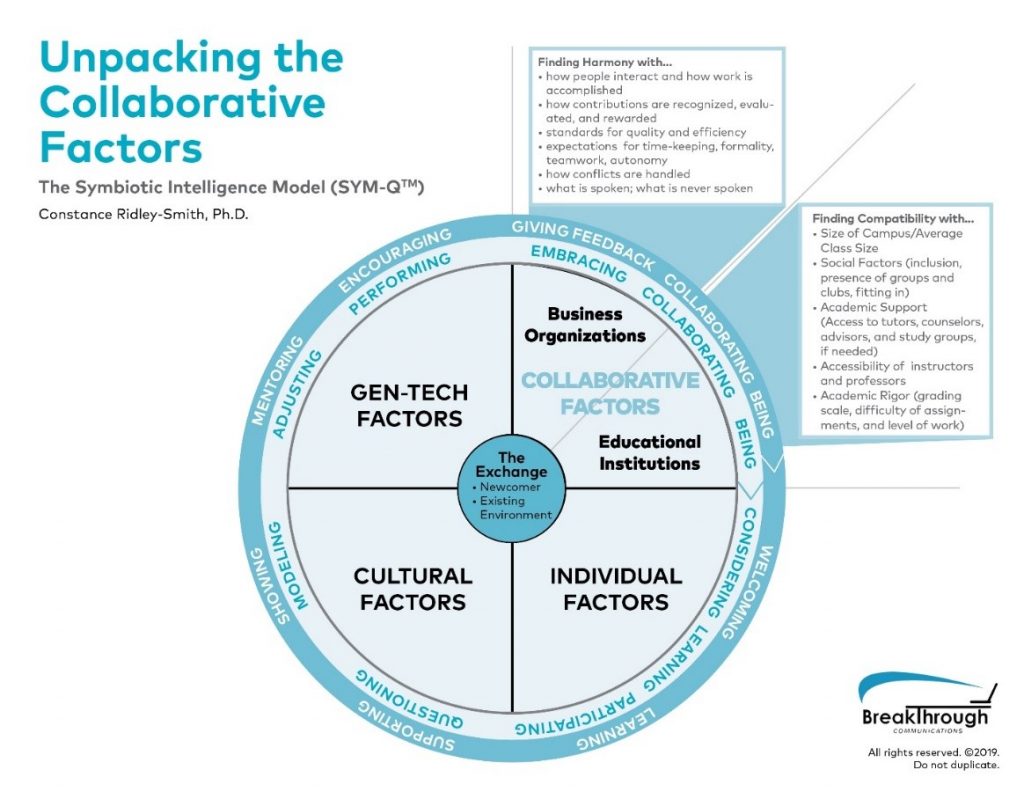
Volume XLII, No. 30 | August 13, 2020
Mastering the Third Culture: Helping Students Navigate the Technology-Based, At-Home Learning Environment
In a widely circulated Youtube video, a troubled student pours out his difficulties with online, learn-from-home modalities. He fears the pandemic and feels trapped in the house. He is frustrated with how his instructor has piled up assignments beyond his ability to organize and finish without duress. Not being able to see his friends or leave the house is isolating. The volume of assignments, his lack of energy and motivation, and not being able to rely upon his teachers to work through these issues has brought him to a breaking point.
These feelings are shared by many students. How do instructors position themselves to facilitate successful student transition to online, technology-based, learn-from-home environments?
In my doctoral and post-doctoral research, now known as the Symbiotic Intelligence Model (SYM-Q), I studied each of the factors the student mentioned. The academic challenges he described are known on the SYM-Q Model as Collaborative Factors.
The original post-doctoral research project was conducted by colleagues at Bowie State University (BSU) in 2017-2018. Our focus was on what happens to students who enter a new culture or new institution, so we sampled on BSU’s new and international students. Our recommendation was to put prescriptive measures in place to help new and international students navigate issues of isolation, anxiety, and stress due to their workload. When this video surfaced on social media, we realized that the same prescriptive measures could be used to help students navigate learning from home. It reinforced that our research findings transcended Bowie State and have relevance in this new (third) culture of technology-based and learn-from-home environments.
With the backdrop of COVID-19, and the sudden thrust to a technology-based, learn-from-home environment, all students have been thrown into a new and foreign learning culture. Instructors must change tactics to prepare their students to navigate this new territory.
Based on the SYM-Q Research, here are some recommendations I offer to instructors and administrators:
- Adjust the readability of assignments. If students are required to work on an assignment independently, structure the assignment at a readability level lower than the normally required readings. Students who learn online are attempting two tasks simultaneously, and independent reading comprehension places a greater tax upon mental faculties than reading guided by an instructor in a traditional lecture.
- Provide academic support. Create virtual student teams so the academic burden of learning and deriving meaning is shifted from one solitary student to a group. Encourage groups to use FaceTime and other collaboration tools so the meetings feel more like face-to-face conversations. Instructors can include successful collaboration within the work team as part of each student’s grade. Be sure to create metrics for evaluating group contributions and communicate the criteria beforehand.
- Vary academic resources. Online resources may seem to be appropriate given current circumstances. However, online resources are best used as a reinforcement to face-to-face instruction. Instructors should make themselves available for FaceTime meetings to answer questions and check in on students’ progress. Many colleges also offer tutoring services that have been moved online. Varying the learning modality allows students to receive the best parts of online and face-to-face instruction.
- Distinguish academic rigor from volume of assignments. Academic rigor can be maintained without increasing the number of tasks or problem sets in an assignment to the point that students feel overwhelmed. Streamline the number of problems or questions by carefully selecting learning tasks that measure several competencies simultaneously.
- Review scheduling of assignments. Invite collaboration among other faculty in your department to schedule assignments within the academic unit or division, or across multiple divisions. Be flexible with students who may have several large projects due at the same time in other classes.
- Practice social inclusion. Students often feel socially isolated when they enter into a new culture. The key to helping a newcomer operate within a new culture successfully is providing adequate support. This reduces social isolation and provides social support, in addition to academic support. Making yourself available during virtual office hours and helping students connect to the resources they need are ways to provide this needed support.
SYM-Q Research shows that when these six methods are practiced, they lead to persistence, retention, and student success. The SYM-Q Model applies also to addressing sub-conscious bias, diversity, and inclusion.
Connye Ridley-Smith, Coordinator, Articulation Agreements
For more information, contact the author at Bermuda College, csmith@college.bm.



